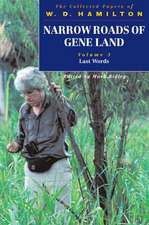Relict Species: Phylogeography and Conservation Biology
Editat de Jan Christian Habel, Thorsten Assmannen Limba Engleză Paperback – 27 noi 2014
| Toate formatele și edițiile | Preț | Express |
|---|---|---|
| Paperback (1) | 1224.85 lei 6-8 săpt. | |
| Springer Berlin, Heidelberg – 27 noi 2014 | 1224.85 lei 6-8 săpt. | |
| Hardback (1) | 1058.77 lei 38-44 zile | |
| Springer Berlin, Heidelberg – 15 dec 2009 | 1058.77 lei 38-44 zile |
Preț: 1224.85 lei
Preț vechi: 1493.72 lei
-18% Nou
Puncte Express: 1837
Preț estimativ în valută:
234.40€ • 254.53$ • 196.90£
234.40€ • 254.53$ • 196.90£
Carte tipărită la comandă
Livrare economică 23 aprilie-07 mai
Preluare comenzi: 021 569.72.76
Specificații
ISBN-13: 9783642424830
ISBN-10: 364242483X
Pagini: 468
Ilustrații: XV, 451 p.
Dimensiuni: 155 x 235 x 25 mm
Greutate: 0.65 kg
Ediția:2010
Editura: Springer Berlin, Heidelberg
Colecția Springer
Locul publicării:Berlin, Heidelberg, Germany
ISBN-10: 364242483X
Pagini: 468
Ilustrații: XV, 451 p.
Dimensiuni: 155 x 235 x 25 mm
Greutate: 0.65 kg
Ediția:2010
Editura: Springer Berlin, Heidelberg
Colecția Springer
Locul publicării:Berlin, Heidelberg, Germany
Public țintă
ResearchCuprins
Relict Species: From Past to Future.- Climate and Ecosystems.- The Changing Climate: Past, Present, Future.- Extra-Mediterranean Refugia, Post-Glacial Vegetation History and Area Dynamics in Eastern Central Europe.- Ancient Relicts.- Review: The Dark Side of Relict Species Biology: Cave Animals as Ancient Lineages.- Relicts Within the Genus Complex Astragalus/Oxytropis (Fabaceae), and the Comparison of Diversity by Objective Means.- Relict Populations and Endemic Clades in Palearctic Reptiles: Evolutionary History and Implications for Conservation.- Niche Conservatism among Allopatric Species of the Grasshopper Genus Afrophlaeoba Jago, 1983 in the Eastern Arc Mountains (Tanzania).- Conservation Genetics and Phylogeography of the Threatened Corsican and Barbary Red Deer (Cervus elaphus corsicanus and C. e. barbarus).- Phylogeographic Analyses of a Boreal-Temperate Ectomycorrhizal Basidiomycete, Amanita Muscaria, Suggest Forest Refugia in Alaska During the Last Glacial Maximum.- Glacial Relicts.- Review Refugial Areas and Postglacial Colonizations in the Western Palearctic.- Multiple Glacial Refuges of Unwinged Ground Beetles in Europe: Molecular Data Support Classical Phylogeographic Models.- Postglacial Recolonization of Continental Europe by the Pygmy Shrew (Sorex minutus) Inferred From Mitochondrial and Y Chromosomal DNA Sequences.- Relicts Since Postglacial Times.- Are Disjunct Alpine and Arctic-Alpine Animal and Plant Species in the Western Palearctic Really “Relics of a Cold Past”?.- Linking Genetics and Ecology: Reconstructing the History of Relict Populations of an Endangered Semi-Aquatic Beetle.- Peripheral Relict Populations of Widespread Species; Evolutionary Hotspots or Just More of the Same?.- Genetic Differentiation Between and Among Refugia.-Population Genetic Structure of Two Threatened Dragonfly Species (Odonata: Anisoptera) as Revealed by RAPD Analysis.- Review Molecular Methods: Blessing or Curse?.- Conservation of Relict Species.- The EU Habitats Directive and the German Natura 2000 Network of Protected Areas as Tool for Implementing the Conservation of Relict Species.- Ecological Limits Vis-à-vis Changing Climate: Relic Erebia Butterflies in Insular Sudeten Mountains.- Conservation and Management of the Habitats of Two Relict Butterflies in the Belgian Ardenne: Proclossiana eunomia and Lycaena helle.- The Future of Relict Species.- Review Modelling Future Trends of Relict Species.- Conservation of the Grey Bush Cricket Platycleis albopunctata (Orthoptera: Tettigoniidae) Under Differing Habitat Conditions: Implications From an Individual-Based Model.- Is the ‘Lost World’ Lost? High Endemism of Aphibians and Reptiles on South American Tepuís in a Changing Climate.- Population Genetics and Ecological Niche Modelling Reveal High Fragmentation and Potential Future Extinction of the Endangered Relict Butterfly Lycaena helle.- Relict Species Research: Some Concluding Remarks.- Erratum.- Erratum.
Notă biografică
Jan Habel:
- Study of environmental sciences, major subjects: ecology, conservation biology, environmental politics (University of Dresden-Zittau and University of Lüneburg, 2003)
- Diploma thesis on habitat fragmentation and population ecology of butterflies (University of Lüneburg, 2003)
- Doctoral thesis on the influence of natural factors and land use changes on the genetic structure of xerothermic animals (University of Trier, 2006)
- Since 2006 working on postglacial relicts, molecular biogeography and conservation genetics (Musée national d´histoire naturelle Luxembourg)
- Doctoral thesis on phylogeography of ground beetles (University of Münster, 1994)
- Postdoctoral thesis on the population history of ground beetles (University of Osnabrück, 2000)
- Since 2001 professor at the University of Lüneburg
- Since 2002 director of the Institute of Ecology and Environmental Chemistry
- 2003-2006 dean of the Faculty of Environmental Chemistry
- Since 2006 full professor at the University of Lüneburg (Animal Ecology)
Textul de pe ultima copertă
This book provides an overview of the importance of research on relict species and presents conclusions and findings on the conservation of these species. There are relict species and populations from nearly all plant and animal groups and they contribute substantially to biodiversity across the globe. Current diversity patterns are influenced by both historic and recent ecological conditions. Relict species are of particular importance, as they usually suffer more severely from human activities than do non-relict populations; the situation is also potentially critical, as many relict species and populations have the potential to colonize large areas when the climate changes.
The more than 27 contributions in this book highlight the history and status of today’s relict species and populations and apply molecular genetics, morphometry, modelling and conservation biology to describe the past and present situations and to predict future trends of relict species’ distribution.
The more than 27 contributions in this book highlight the history and status of today’s relict species and populations and apply molecular genetics, morphometry, modelling and conservation biology to describe the past and present situations and to predict future trends of relict species’ distribution.
Caracteristici
The book provides an unique overview at the interface between phylogeography and conservation biology of relict species Includes supplementary material: sn.pub/extras
















